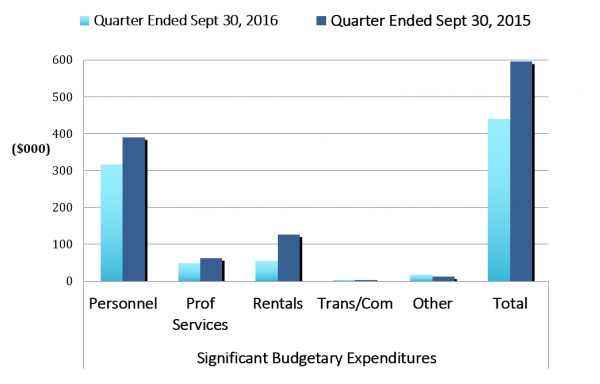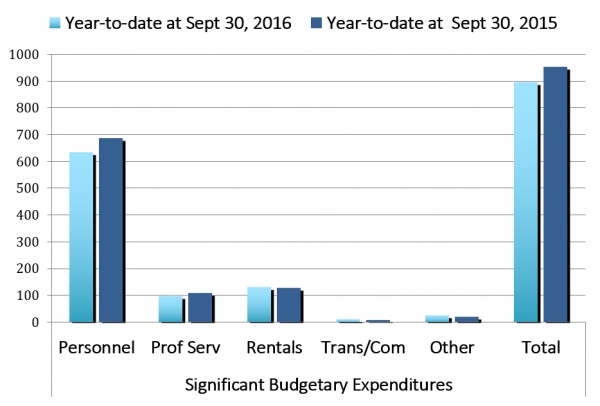Quarterly Financial Report ending September 30, 2016
Statement outlining results, risks and significant changes in operations, personnel and program
1. Introduction
1.1 Background to the Quarterly Report
As per the Treasury Board Accounting Standard (TBAS) 1.3, the Office of the Communications Security Establishment Commissioner (Office) is submitting its quarterly report.
This section of the quarterly financial report should be read in conjunction with the Main Estimates (and as applicable - Supplementary Estimates and previous interim reports for the current year). The report has been prepared by management as required by section 65.1 of the Financial Administration Act and in the form and manner prescribed by the Treasury Board. This quarterly financial report has not been subject to external audit or review.
1.2 Authority, Mandate and Program
The position of Communications Security Establishment Commissioner was created to review the activities of Communications Security Establishment (CSE) to determine whether it performs its duties and functions in accordance with the laws of Canada. This includes having due regard for the privacy of Canadians.
The Commissioner derives his authority and mandate from the National Defence Act:
- reviewing CSE activities to ensure they comply with the law;
- conducting any investigations deemed necessary in response to complaints about the CSE;
- reviewing and reporting annually to the Minister on review activities carried out under an (ministerial) authorization
- informing the Minister of National Defence and the Attorney General of Canada of any CSE activities that may not be in compliance with the law; and
- submitting to the Minister for tabling in Parliament, within 90 days after the end of each fiscal year, an annual report on the Commissioner's activities and findings.
In addition the Commissioner also has a mandate under the Security of Information Act to receive information from persons who are permanently bound to secrecy seeking to release special operational information on the grounds that it is in the public interest.
Further information on the mandate, roles, responsibilities and programs of the Office can be found in the Office's 2016–17 Report on Plans and Priorities and in the
Main Estimates.
1.3 Basis of Presentation
This quarterly report has been prepared by management using an expenditure basis of accounting. The accompanying Statement of Authorities includes the Office's spending authorities granted by Parliament and those used by the Office consistent with the Main Estimates and Supplementary Estimates (as applicable) for the 2016–17 fiscal year. This quarterly report has been prepared using a special purpose financial reporting framework, designed to meet financial information needs with respect to the use of spending authorities.
The authority of Parliament is required before monies can be spent by the Government. Approvals are given in the form of annually approved limits through appropriation acts or through legislation in the form of statutory spending authority for specific purposes.
When Parliament is dissolved for the purposes of a general election, section 30 of the Financial Administration Act authorizes the Governor General, under certain conditions, to issue a special warrant authorizing the Government to withdraw funds from the Consolidated Revenue Fund. A special warrant is deemed to be an appropriation for the fiscal year in which it is issued.
The Office uses the full accrual method of accounting to prepare and present its annual departmental financial statements that are part of the departmental performance reporting process. However, the spending authorities voted by Parliament remain on an expenditure basis.
2. Highlights of fiscal quarter and fiscal year-to-date results
It should be noted that the Authorities in the Statement of Authorities and the Planned Expenditures in Table 1: Departmental Budgetary Expenditures by Standard Object have been adjusted to account for the receipt of the operating budget carry-forward ($85,435) from fiscal year 2015–16.
Second Quarter

As reflected in the attached Statement of Authorities and in Table 1 Departmental Budgetary Expenditures by Standard Object (below) and illustrated in the chart (above), the Office's second quarter spending in 2016–17 is down $155 thousand from the same quarter of the previous year.
This decrease can be attributed to the following factors:
- an decrease of $72 thousand personnel costs due to the timing of performance pay (3rd quarter in 2016–2017 as opposed to 2nd quarter in 2015–16), net reduction in personnel costs due to staff turnover, and timing delays in the processing of pay;
- a decrease of $73 thousand for rent due to the payment of 6 months rent in the 2nd quarter of 2015–16 as a result of late billings, as opposed to the 3 months rent paid in the 2nd quarter of 2016–17;
- a decrease of $15 thousand for professional services due to a reduction in overall professional service requirements and timing differences in the billing by suppliers of shared services; and
- an increase in other costs of $5 thousand.
Year-to-date

As reflected in the attached Statement of Authorities and in Table 1 Departmental Budgetary Expenditures by Standard Object (below) and illustrated in the chart (above), the Office's year to date spending in 2016–17 is down $58 thousand from the year-to-date expenditures in 2015–16.
This change can be attributed to the following factors:
- a decrease in personnel costs of $53 thousand due to the timing of performance pay in 2016–17 and a net reduction in overall personnel costs due to staff turnover;
- a decrease in professional services of $14 thousand due to a reduced requirement for advisory services and timing delays by suppliers for costs related to shared services; and
- an overall increase of $9 thousand in all other costs, due to slight increases in the cost of information and communication services ($2 thousand), travel ($1 thousand), materials and supplies ($3 thousand) and rent ($3 thousand).
3. Risks and Uncertainties
The program is being delivered as intended within the resources available. The Office is in the process of filling a review officer position to ensure program delivery is not impacted.
4. Significant changes in relation to operations, personnel and programs
The Office is in the process of filling a full-time review officer position as a result of an employee departure during the second quarter. There were no significant changes in relation to operations and programs.
5. Approval by Senior Officials
Original signed by:
The Honorable Jean-Pierre Plouffe, CD
Commissioner
J. William Galbraith
Chief Financial Officer
Ottawa, Canada
November 10, 2016
Statement of Authorities (unaudited)
| Total available for use for the year ending March 31, 2017 | Used during the quarter ended Sept 30, 2016 | Year to date used at quarter-end | |
|---|---|---|---|
| Vote 1 - Program Expenses | 2,026 | 393 | 803 |
| Statutory authorities – Contributions to employee benefit plans | 185 | 47 | 93 |
| Total Budgetary authorities | 2,211 | 440 | 896 |
| Total authorities | 2,211 | 440 | 896 |
| Total available for use for the year ended March 31, 2016 | Used during the quarter ended Sept 30, 2015 | Year to date used at quarter-end | |
|---|---|---|---|
| Vote 1 - Program Expenses | 1,942 | 550 | 864 |
| Statutory authorities – Contributions to employee benefit plans | 181 | 45 | 90 |
| Total Budgetary authorities | 2,123 | 595 | 954 |
| Total authorities | 2,123 | 595 | 954 |
Table 1: Departmental Budgetary Expenditures by Standard Object (unaudited)
| Expenditures | Planned expenditures for the year ending March 31, 2017 | Expended during the quarter ended Sept 30, 2016 | Year to date used at quarter-end |
|---|---|---|---|
| Personnel | 1,323 | 317 | 634 |
| Transportation and communications | 32 | 4 | 10 |
| Information | 24 | 10 | 14 |
| Professional and special services | 446 | 48 | 96 |
| Rentals | 317 | 54 | 130 |
| Repair and maintenance | 4 | 1 | 1 |
| Utilities, materials and supplies | 27 | 6 | 11 |
| Acquisition of land, buildings and works | 0 | 0 | 0 |
| Acquisition of machinery and equipment | 38 | 0 | 0 |
| Other subsidies and payments | 0 | 0 | 0 |
| Total gross budgetary expenditures | 2,211 | 440 | 896 |
| Total net budgetary expenditures | 2,211 | 440 | 896 |
| Expenditures | Planned expenditures for the year ending March 31, 2016 | Expended during the quarter ended Sept 30, 2015 | Year to date used at quarter-end |
|---|---|---|---|
| Personnel | 1,258 | 389 | 687 |
| Transportation and communications | 40 | 3 | 9 |
| Information | 17 | 7 | 12 |
| Professional and special services | 470 | 63 | 110 |
| Rentals | 310 | 127 | 127 |
| Repair and maintenance | 1 | 1 | 1 |
| Utilities, materials and supplies | 17 | 5 | 8 |
| Acquisition of land, buildings and works | 0 | 0 | 0 |
| Acquisition of machinery and equipment | 10 | 0 | 0 |
| Other subsidies and payments | 0 | 0 | 0 |
| Total gross budgetary expenditures | 2,123 | 595 | 954 |
| Total net budgetary expenditures | 2,123 | 595 | 954 |
- Date modified: